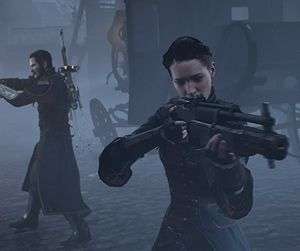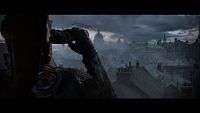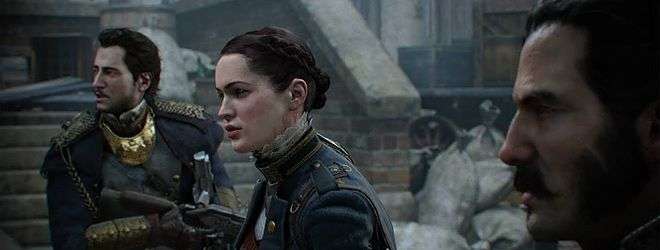The Order: 1886 – Preview
by Mark R
|
 There’s an odd thing happening within the games industry where the transition between cut-scene and live gameplay has become blurred to the point that it’s almost impossible to know where one ends and the other begins. At times, the only hint is that those around the main character suddenly stop responding to anything and appear to be waiting around for something, and that ‘something’ invariably ends up being you. As a proponent of deep immersion in games, and openly whorish when it comes to graphics, it may come as a surprise that one of my greatest worries is that games will become too realistic and that we won’t actually enjoy playing them anymore, as gameplay is slowly being swallowed by technical prowess. It is our paradigm shift; the long-established history of gameplay overshadowing aesthetics has been turned on its head and, sadly, the results tend to be shallow glamours.
There’s an odd thing happening within the games industry where the transition between cut-scene and live gameplay has become blurred to the point that it’s almost impossible to know where one ends and the other begins. At times, the only hint is that those around the main character suddenly stop responding to anything and appear to be waiting around for something, and that ‘something’ invariably ends up being you. As a proponent of deep immersion in games, and openly whorish when it comes to graphics, it may come as a surprise that one of my greatest worries is that games will become too realistic and that we won’t actually enjoy playing them anymore, as gameplay is slowly being swallowed by technical prowess. It is our paradigm shift; the long-established history of gameplay overshadowing aesthetics has been turned on its head and, sadly, the results tend to be shallow glamours.
Imagine, then, a game where the most obvious trait is that of exquisite aesthetics, yet the gameplay itself is not only immersive but also gripping, and those dreaded cut-scenes are so deeply integrated that transitions are not only seamless, but also take nothing away from the entire experience. A game which is so utterly cinematic in its delivery that you’d be forgiven for thinking it was a modern take on Cinematronics’ old laserdisc-based games – Dragon’s Lair and Space Ace – where the ‘player’ was simply watching a movie play out and would be prompted periodically for pre-defined button presses to continue ‘playing’ the game, essentially making it a sixty-minute-long QTE. As incredible – and pivotal – as the technology was, there was as much actual gameplay involved in those games as you’d find eating a tube of Pringles. Thankfully, Ready At Dawn haven’t fallen into that trap and have instead created what I would consider to be the first truly cinematic game that I’ve played.
Set in an alternative version of Victorian London (which, to my mind, was always a romantic era yet now prompts the thought “can you smell cum?”, thanks to Mitchell and Webb), The Order: 1886 follows the plight of the knights from Arthurian legend, with our protagonist being none other than Sir Galahad, as they battle to save humanity from an uprising of ‘half breeds’ who have somehow managed to claw their way through every attempt to eradicate them. These demonic creatures mostly exist under the guise of regular humans, only taking on their beastly forms when necessary in what would appear to be Ready At Dawn’s take on lycan mythology. Utilising a hybrid of period weaponry, steampunk design, and futuristic technology, The Order are better equipped to destroy this inhuman race than those who have gone before them and it this technology that allows the IP to stand head and shoulders above other upcoming releases.
 Juxtaposed against the smoke-stacked roofs, imposing skyline, and dreary streets, are powered Zeppelins overhead and bursts of light from energy guns the likes of which appear to extend far beyond the level of technology available at the time. What allows this stark contrast to work, however, is that it is entirely plausible – Tesla’s work with arc light in 1886 means that the Arc Gun isn’t too far removed from what might have been, and the beautifully executed Thermite Rifle may not have been possible at the time but the science behind it was only seven years away, so it is feasible to consider that the technology could have reached the experimental stage by that point. It is this speculative fiction which drives the narrative of The Order, and which reinforces the notion that it’s not merely some far-fetched historical/futuristic hybrid.
Juxtaposed against the smoke-stacked roofs, imposing skyline, and dreary streets, are powered Zeppelins overhead and bursts of light from energy guns the likes of which appear to extend far beyond the level of technology available at the time. What allows this stark contrast to work, however, is that it is entirely plausible – Tesla’s work with arc light in 1886 means that the Arc Gun isn’t too far removed from what might have been, and the beautifully executed Thermite Rifle may not have been possible at the time but the science behind it was only seven years away, so it is feasible to consider that the technology could have reached the experimental stage by that point. It is this speculative fiction which drives the narrative of The Order, and which reinforces the notion that it’s not merely some far-fetched historical/futuristic hybrid.
What is out of the ordinary, however, is the other-worldly substance by the name of Black Water, which is the key to the knights’ longevity and is also used to induce rapid healing. At this point it’s important to mention that, while several hundred years old, Galahad and his comrades are not immortal, as that would negate any need to avoid damage, rendering the ‘cover-shooter’ aspect entirely redundant. The section I played through – entitled Chapter III: Inequalities – featured Galahad and his team facing off against rebels by a distillery with gunfire coming from all angles. It was here that we were first introduced to the Thermite Rifle which, when fired, initially shoots a burst of the compound towards the target area and is followed up by a standard shot which then ignites the powder as it falls to the ground. The result is a spectacular display of the PlayStation 4′s physics and dynamic lighting as a mad burst of white-hot particles explode into the air to burn those in close proximity, and is not only ideal for dispatching enemies but also injuring those who remain in cover if used wisely.
 |
 |
 |
 |
 |
 |
In the throes of a frantic gunfight, however, strategy is the key to survival as the two-stage process required by the Thermite Rifle means it’s not possible to offer rapid retaliatory fire, as the first shot of compound is useless without the follow-up ignition shot. To that end, every single shot must be carefully considered, but at a much quicker pace than most gun-based titles, as failing to fire off the second round in the designated timeframe would mean starting the entire process over. In a sniper game, that may be acceptable, but when your enemies are in great numbers and mere metres away, it’s a recipe for disaster and so it’s more likely that you’ll opt for the pistol even though it’s nowhere near as exhilarating to do so.
 Thankfully, Ready At Dawn are undoubtedly aware of this fact and have countered it with some enhanced abilities, courtesy of the aforementioned Black Water. As well as the healing and regenerative properties of the mysterious liquid, it comes with a useful perk known as Blacksight. When used, the action immediately desaturates and time around you is slowed to the point where it’s possible to perform a more considered attack before the effect wears off and goes into cooldown. In battles against the revolting rebels, it may serve as a means to better utilise whatever weaponry is at your disposal, but in the moments where one of the half-breed enemies is bearing down on you, I imagine this effect will further exaggerate the sinister aspect and prolong the agony as there’s no way a few shots will take these brutes down.
Thankfully, Ready At Dawn are undoubtedly aware of this fact and have countered it with some enhanced abilities, courtesy of the aforementioned Black Water. As well as the healing and regenerative properties of the mysterious liquid, it comes with a useful perk known as Blacksight. When used, the action immediately desaturates and time around you is slowed to the point where it’s possible to perform a more considered attack before the effect wears off and goes into cooldown. In battles against the revolting rebels, it may serve as a means to better utilise whatever weaponry is at your disposal, but in the moments where one of the half-breed enemies is bearing down on you, I imagine this effect will further exaggerate the sinister aspect and prolong the agony as there’s no way a few shots will take these brutes down.
One thing which struck me more than anything with The Order, however, was how the developers are still extending the opportunity to forego the linear cinematic approach by interacting with the surroundings. With all of the ‘cut scenes’ being rendered in real-time by the engine, there is no need to drop in and out of pre-rendered footage, so if one of the story elements is playing out and there’s something which catches your eye, you’re free to examine it further rather than be forced into sitting through the entire scene or skip past it entirely.
Graphically, Ready At Dawn have gone beyond anything that has come before, in terms of realism. It’s not down to ridiculously-high-res textures and massive polygon counts, however; it comes from the lengths they’ve gone to in order to mimic a true cinematic masterpiece. When in a darkened area the look takes on a grainier feel, just as it would with a lower film speed, and it becomes clearer and sharper in more brightly lit environments. We also see very obvious chromatic aberration at times, as though everything had been filmed rather than rendered, and this undoubtedly has to be calculated in real time by the engine. These may be viewed as mere gimmicks, and could turn out to be put in place to distract from sub-par gameplay, but it certainly aids the realism. Add to this a destructible environment and some of the best dynamic lighting, and most detailed models and textures I’ve ever seen in my thirty-odd years of gaming, and The Order: 1886 could be the game changer of this generation if they don’t do anything to derail it.
 |
 |
 |
 |
 |
 |
Although many have likened the mechanics of The Order to those of Gears of War and other cover-based shooters, I would dismiss these comparisons as much as I would someone likening Virtua Tennis to Pong. There may be a team of support units alongside the protagonist, a need to take cover from heavy fire (which any sane person would do, anyway), and a linear progression through the story… but those are nothing more than accepted mechanics that you’d find in a few dozen other titles, so the comparison, in that respect, is unfair. Everything that I saw and experienced at E3 took gaming to an entirely new level of immersion and realism, and even though I was hesitant about just how damaging that could be to gameplay – especially given the linear nature of the campaign – the effect was that The Order has moved to the top of my watch list.
Last five articles by Mark R
- From Acorns to Fish
- Alone In The Dark
- Why Borderlands is Better Than Borderlands 2
- Falling Short
- The Division: A Guide to Surviving the Dark Zone Solo
























There are no comments, yet.
Why don’t you be the first? Come on, you know you want to!